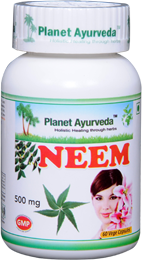Ayurvedic Treatment of Candidiasis (Yeast Infection)

About Candidiasis
Candidiasis is a fungal infection that can affect any area of body such as skin, genitals, throat, mouth & blood. It is caused by the yeast called Candida. There are about 20 species of candida that may cause infection but Candida albicans is most common yeast infection. Normally it is found in small amount in human body but overgrowth of candida results in infection or diseased condition. This problem can be managed with the help of modern science as well Ayurvedic theory.
According to Ayurveda, to eradicate the yeast infection it is important to address the main cause of infection while using herbal formulations to balance the body towards health. There are numerous herbs present in nature that help to manage the symptoms associated with disease such as Lodhra (Symplocus racemosa), Ashok (Saraca indica), Udumbur (Ficus glomerata) & Arjuna (Terminalia arjuna).
Types of Candidiasis
There are several types of candidiasis according to the part of body affected. These are:
- Oral Candidiasis: Infection of mouth or throat is called Oropharyngeal/ Esophageal candidiasis or thrush. It commonly occurs in children.
- Genital Candidiasis: Infection of genital area is called yeast infection. It is also called vaginal yeast infection or vulvovaginal candidiasis in women.
- Diper Rash: It mainly occurs in babies in the bottom area.
- Invasive Candidiasis or Candidemia: When infection enters the blood stream is known as invasive candidiasis.
Symptoms of Candidiasis
Symptoms may vary in person and area affected by infection.
Some common symptoms may include:
- Redness
- Itching
- Swelling
- Rashes
- Burning sensation
Causes of Candidiasis
Small amount of yeast (candida) is present over the skin naturally but in excess it may cause infection that may be due to some reasons. It depends upon the area affected by candida.
The common causes may include:
- Environmental factors – warm weather and moist area are more common for growth of candida albicans
- Tight clothing
- Unhygienic conditions
- Medicines – antibiotics used to kill harmless bacteria and fungi
- Weak immune system
- Wet skin
- Diseased condition – diabetes, pregnancy or any other medical complication
Ayurvedic Outlook
In Ayurveda, candidiasis is considered as Agnimandya or deficient digestion. Due to improper digestion accumulation of toxins (ama) occur in body which is by product of undigested food. These toxins enter into blood stream or lymphatic system which creates toxicity and results in many health diseases. It mainly occurs at the seat of vata in the lower digestive tract. As the ama accumulates in the large and small intestines, it will putrefy and ferment thus inhibiting the normal flora from proliferating. Then in next stage, the growth of candida is a result of intestinal absorption of ama into liver and blood.
According to Ayurveda, there are three doshas responsible for candidiasis which are explained below:-
- Vata dosha – It is mainly due to excessive intake of pungent, bitter, sweet, high proteins, wheat, dairy, nuts & cold food items. Irregular eating and sleeping habits are responsible for increased vata in body. The main symptoms of vata dosha are dryness of skin, nervousness, mood instability, inability to cope, constipation & energy imbalance.
- Pitta dosha – It is aggravated due to intake of pungent, spicy, sour and acidic foods.
- Kapha dosha – Kapha is aggravated by excessive intake of heavy, oily and cold food items. Overeating and sleeping immediately after breakfast or lunch generates Ama (toxins) in body.
Management of Candidiasis
Candidiasis can be managed with the help of Ayurvedic medicines. Ayurveda provides herbal and natural remedies to manage the symptoms of candidiasis. It mainly works on the principle to balance all tri energies (vata, pitta and kapha). There are numerous herbs present in nature that help to manage the symptoms associated with disease such as Lodhra (Symplocos racemosa), Ashok (Saraca indica), Udumbur (Ficus glomerata) & Arjuna (Terminalia arjuna).
Herbal Remedies for Candidiasis by Planet Ayurveda
Planet Ayurveda offers effective herbal remedies such as Neem capsules, Gandhak Rasayan, Manjistha capsule & Nirgundi oil for ayurvedic treatment of candidiasis (yeast infection). These herbal remedies are prepared from using best quality herbs and strictly follow the principles of Ayurveda. All these herbal remedies of Planet Ayurveda are 100 percent pure, natural and vegetarian. These are free from chemicals, additives and preservatives. These are safe to use as these are free from side effects.
1. NEEM CAPSULES
It is 100% natural product offered by Planet Ayurveda which is obtained from standardized extract of herb neem (Azadirachta indica) belongs to family Meliaceae.
USES:-
- It helps to maintain healthy skin.
- The capsule possesses anti-bacterial and anti-inflammatory properties.
- Use of neem capsules show positive effects on skin diseases like eczema, acne or psoriasis.
DOSE: 1-2 capsules twice daily with plain water after meals.
2. GHANDHAK RASAYAN
These are herbal tablets which are made from Shuddh Gandhak (Purified Sulphur). The word rasayan means rejuvenation. Its natural property is to rejuvenate the body without any side effect. These tablets help to remove toxins from body.
DOSE: 1-2 tablets twice in a day with plain water after meals.
3. MANJISTHA CAPSULES
These capsules are prepared from standardized extract of herb (Rubia cordifolia) that give effective result in candidiasis. Manjistha capsules manage all signs & symptoms associated with candidiasis.
Dose : 1-2 capsules twice daily with plain water after meals.
4. NIRGUNDI OIL
It is an herbal oil with different herbs which are given below:
- Til oil (Sesamum indicum)
- Manjistha (Rubia cordifolia)
- Haridra (Curcuma longa)
- Nirgundi (Vitex negundo)
- Kalihari (Gloriosa superba)
BENEFITS:- It has anti-inflammatory properties which helps to pacify the inflammation.
Direction for use:- It is for external use only. Apply on affected skin area. Leave it for 10-15 minutes and wash with lukewarm water. It is more beneficial to apply Nirgundi oil before bath to reduce swelling, pain and irritation.







